| This is a personal diary, not an official report. There is also a separate article on
Yenisey. Click on small framed photos to see enlargements. Captain: Bengt
Grisell, Royal Institute of Technology. Other crew from Stockholm: Lorelei Randall-Grisell, diver
Staffan von Arbin, diver Per Åkesson, Bertil Stjernstedt, Leif Nylén, and captain's daughter Dunja
Grisell with friend Jane Svensson. Finally we have the ship dog Gillis.
This expedition was made in cooperation with underwater archaeologists in Estonia, Latvia, and
Russia. The purpose of the expedition was partly to search for and document wrecks, and partly to
exchange knowledge on documenting a find without destroying it. Our plan was first to work in
Estonia, then, if we'd have time, to work in Latvia, and finally to participate in the opening of a
new exhibition in St Petersburg, Russia, "The Heritage of the Baltic sea".
Saturday 1993-06-12 Departure from Stockholm
We cross the Baltic Sea in calm weather. Navigation is easy thanks to
GPS, sea charts and compass.
Sunday 1993-06-13 Estonia, and "wreck 1"
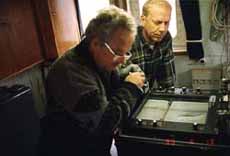 In
the morning we are close to the Estonian coast, where we are met by the ex fishing boat Mare from
Meremuuseum (Estonian national maritime museum). It is now a research ship
under command by Vello Mäss, with the divers: Kaido Peremees, Avo Jüris, Andrus Pint, Margus Tooming,
the mechanic Jüri-Kant Soobin and the sailor Andres Eero. We are on the site for the previously
located but unidentified "wreck 1". We take sonogram "pictures" with our side
scan sonar (photo 1), then a couple of Estonians go down and look. They pick up a
small bronze cannon, probably a signal cannon. In
the morning we are close to the Estonian coast, where we are met by the ex fishing boat Mare from
Meremuuseum (Estonian national maritime museum). It is now a research ship
under command by Vello Mäss, with the divers: Kaido Peremees, Avo Jüris, Andrus Pint, Margus Tooming,
the mechanic Jüri-Kant Soobin and the sailor Andres Eero. We are on the site for the previously
located but unidentified "wreck 1". We take sonogram "pictures" with our side
scan sonar (photo 1), then a couple of Estonians go down and look. They pick up a
small bronze cannon, probably a signal cannon.
Then we continue to the located wreck site of Yenisey, laying on 47 m
depth. Yenisey was a 90 m long Russian mine ship that was torpedoed by the German submarine U26 on
June 4, 1915. Yenisey sank with 297 men. We find the wreck site with our GPS and take pictures with
side scan sonar.
Mon 1993-06-14 Tallinn
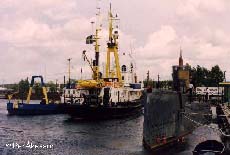 In
the morning we go to Pirita harbour outside Tallinn, where we moor by the side of the Estonian museum
submarine Lembit from 1936 (photo 2). In the afternoon we make a short visit to the
Estonian capitol's old town. I see that Estonia's economy has developed very rapidly since
independence in August 1991. The evening ends with a very nice party with the Estonian divers inside
in the beautifully polished Lembit. Mr Koppelmann, Lembit's "Commanding Officer" and military
historian, has prepared sandwiches and the good Estonian beer Saku. In
the morning we go to Pirita harbour outside Tallinn, where we moor by the side of the Estonian museum
submarine Lembit from 1936 (photo 2). In the afternoon we make a short visit to the
Estonian capitol's old town. I see that Estonia's economy has developed very rapidly since
independence in August 1991. The evening ends with a very nice party with the Estonian divers inside
in the beautifully polished Lembit. Mr Koppelmann, Lembit's "Commanding Officer" and military
historian, has prepared sandwiches and the good Estonian beer Saku.
Tue 1993-06-15
We are visited by Vladimir Dubovik from the diving club in Narva. He shows photos from the find of
a crashed Russian plane from WW2 in Narva river.
Fri 1993-06-18 Divers on visit
In the evening we are visited by Finnish and Estonian divers who show us some well made video
films from different wrecks. They are from Hiiumaa (Dagö), Norway and the Finnish coast. The oldest
wreck was from 17th century, the youngest was Königin Luise (sunk 1939) and a US built Liberty ship
(sunk 1948). The evening ends with dinner including a salad with wonderful garlic dressing.
Sun 1993-06-20
Curt Östman arrives, diver from Stockholm. Then Maik Springmann comes. Maik is diver and marine
historian from Rostock in Germany.
Mon 1993-06-21 Paldiski
At 1045 hours at last we are on our way towards Yenisey. Unfortunately the sea is rough. We go in
shelter from the wind outside the old Soviet navy base Paldiski. The weather does not improve so we
stay anchored over night. We meet the two Swedish divers Lars Gustafsson and Jaan Joandi that have
joined Mare's crew. In the afternoon we make a practice dive down along the anchor chain to the
bottom on 18 m depth and check our equipment.
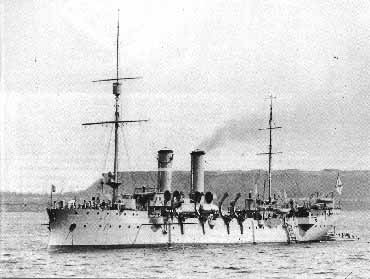 Tue
1993-06-22 Yenisey Tue
1993-06-22 Yenisey
Now we need to be at Yenisey early before the wind increases. We get up at 5 and are on our way at
ten to six. In the morning Curt got three flounders in his net, but we don't dare to keep them. Who
knows what the Russian military has thrown in the water outside Paldiski? We arrive at Yenisey
(photo 3) and the two Swedes on Mare go down at once.
They are down about one hour with their SSBA AGA (a.k.a.
Interspiro) mask system with air and phone from the surface (photo 4). They also
carry 300 bar tanks on their backs as a backup system. The divers come up with a compass from the
steering house roof and report good visibility, about 10-15 m. It is totally dark and you need a good
lamp. The wreck is laying with a 35-40 degrees list on starboard side, 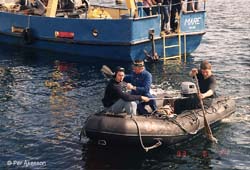 because
of its deep V keel. It is partially covered with old fishing trawls laying on deck or hanging between
sticking up parts. In the cabins, floors are covered by a 40 cm layer of silt, that has accumulated
during the decades. because
of its deep V keel. It is partially covered with old fishing trawls laying on deck or hanging between
sticking up parts. In the cabins, floors are covered by a 40 cm layer of silt, that has accumulated
during the decades.
Two Estonians go down and fasten a mooring rope on the wreck for Mare. They tell us about clocks
and instruments on the inside walls of the steering house, which they have more felt than seen in the
bad visibility of the stirred up dirt. Thereafter the weather unfortunately gets worse. Both we and
Mare anchor 3 seamless south of Yenisey in a bay at the coast, in relative shelter. There we stay
during the afternoon and night. Divers from Mare show us the compass from Yenisey, and report good
visibility (about 15 m) and a very well preserved wreck. Meanwhile, 5 people on Altair become more or
less seasick in the bad weather.
Wed 1993-06-23 Estonian Midsummer's eve
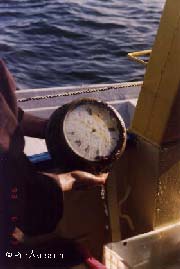 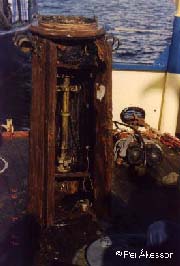 We sleep until 10 AM. The wind is calmer and by 11 we leave together with Mare towards Yenisey. Two
divers go down and fasten another rope to the wreck, and now we also moor to the wreck.
We sleep until 10 AM. The wind is calmer and by 11 we leave together with Mare towards Yenisey. Two
divers go down and fasten another rope to the wreck, and now we also moor to the wreck.
The divers report rather good visibility on the wreck, about 6 m. Estonian divers bring up the
binnacle, i.e. housing (photo 5) of the earlier recovered compass and a few other
small things. The most interesting find is a clock (photo 6) where rust stains from
the hands still point at 20 past 10. According to the German log, she was sunk at 08:27. But that was
German time, and Russian time was 10:27. Thus we can assume that this clock shows the time of the
sinking. Some machine gun ammo is taken up, still intact in its fabric bands. Altogether we only take
up a few objects for the maritime museum. All objects are placed in water buckets or kept wrapped in
wet blankets until we return to the conservation department in Tallinn.
The Mare divers use air hose and AGA full mask with surface air and telephone to one of the
Swedish divers, who thus can be down longer time. Unfortunately one diver breaks an eardrum and
cannot dive more for this time. Bengt and Curt are about to go down to video film, then water leaks
into the video casing and destroys the video camera. Bad luck! When Bengt and Curt go down again to
the cannon on the wreck's fore deck visibility is bad, about 2 m. The weather is calm and for the
first time we stay on the wreck over night.
Thu 1993-06-24
We sleep till 9 AM on a wind still sea. On Mare the divers are already in action. Divers from Mare
go directly and bring up some loose items from the wreck. They tell us that for the first time
visibility is so good that they can see the wreck without lamp. We consider starting by sucking out
the silt and mud layers with the airlift. Then
placing out powerful lamps, and finally documenting the wreck.
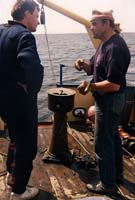 We
get quick results from Mare's divers, including an entire, slightly rusty Maxim machine gun from the
port bridge wing, that was laying loose by the door to the steering house. Then comes a steering
wheel console with rudder indicator from stern deck, unfortunately with broken steering wheel, maybe
by fishing trawl or net. Bengt and Curt install a fixed "metal gas" lamp in the steering house. That
lamp is powered from the surface and uses 400 watt power but leaves light corresponding a 2000 watt
light bulb. We prepare our airlift by assembling long tube segments. Maik goes down alone with air
hose and telephone from Mare. Staffan goes on the wreck with Bengt and Curt, and reports 10 m
visibility in the light of the fixed lamp. I wonder if I will get an opportunity to dive – when, and
where. But the security requirements decide, and I'm less experienced than other divers. We
get quick results from Mare's divers, including an entire, slightly rusty Maxim machine gun from the
port bridge wing, that was laying loose by the door to the steering house. Then comes a steering
wheel console with rudder indicator from stern deck, unfortunately with broken steering wheel, maybe
by fishing trawl or net. Bengt and Curt install a fixed "metal gas" lamp in the steering house. That
lamp is powered from the surface and uses 400 watt power but leaves light corresponding a 2000 watt
light bulb. We prepare our airlift by assembling long tube segments. Maik goes down alone with air
hose and telephone from Mare. Staffan goes on the wreck with Bengt and Curt, and reports 10 m
visibility in the light of the fixed lamp. I wonder if I will get an opportunity to dive – when, and
where. But the security requirements decide, and I'm less experienced than other divers.
Fri 1993-06-25 Swedish midsummer's eve
Too rough weather. We disconnect our ships from the wreck in the morning and anchor close to the
coast. We stay the whole day waiting for better weather. In the afternoon the Swedish divers have to
go home. The planned use of the airlift must wait till another time. In the evening we all eat a
fantastic midsummer dinner.
Sun 1993-06-27
Maik goes out with Mare for a few days' diving on "wreck 1".
Tue 1993-06-29 Small Rågö (Väike Pakri)
In the morning we take a few fine images of Yenisey with side scan sonar. Then Mare returns from
"wreck 1", and they tell us that it is probably the lightship Hiiumadal (Neckmannsgrund), and not the
cargo ship Lisa, as we first thought. Both were torpedoed in 1940. We dive again on Yenisey. In the
afternoon the wind increases so we leave for the night towards Paldiski together with Mare. We don't
dare to dive there since the Soviet navy has thrown a lot of explosives there. We go ashore on the
previously Swedish island Small Rågö, close to Paldiski. Of the Swedish houses only the foundations
remain. But of the church the tower is still standing. On the churchyard all graves are dug up, maybe
by Soviet soldiers looking for gold.
Wed 1993-06-30 Shooting range
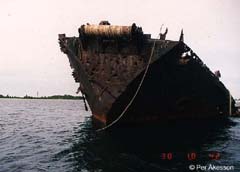 In
the morning we go to Large Rågö (Suur Pakri) and search with side scan sonar for the wreck of the
Russian battleship Vsevolod. In 1808, Sweden and Britain was at war against Russia. In August, the 74
gun Vsevolod, was run aground by the British navy ships Implacable and Centaur. The Russians
surrendered, and Vsevolod was burned and sunk. Fishermen have told us that the wreck on 15 m depth
sometimes is visible from the surface. But we find nothing. In
the morning we go to Large Rågö (Suur Pakri) and search with side scan sonar for the wreck of the
Russian battleship Vsevolod. In 1808, Sweden and Britain was at war against Russia. In August, the 74
gun Vsevolod, was run aground by the British navy ships Implacable and Centaur. The Russians
surrendered, and Vsevolod was burned and sunk. Fishermen have told us that the wreck on 15 m depth
sometimes is visible from the surface. But we find nothing.
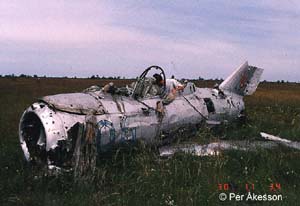 We
anchor and go ashore on the island where there used to be a Soviet exercise shooting range. At the
shore we find wrecked target ships, full of holes. On land, among large bomb craters, we see hundreds
of bombs (or dummies?) not yet exploded. As targets we see old trucks and an old Mig jet fighter. We
don't step on the bombs, and survive our little walk. Then we follow Mare back to Tallinn. We
anchor and go ashore on the island where there used to be a Soviet exercise shooting range. At the
shore we find wrecked target ships, full of holes. On land, among large bomb craters, we see hundreds
of bombs (or dummies?) not yet exploded. As targets we see old trucks and an old Mig jet fighter. We
don't step on the bombs, and survive our little walk. Then we follow Mare back to Tallinn.
Fri 1993-07-02 Narva
In Tallinn Curt rents a car. The girls, Staffan and I are invited to follow on a day trip to
Narva. The city is partly a disappointment. The fine 17th century city was bombed during the war and
the rest demolished by the Soviet authorities to build "modern" apartment blocks. Only the city hall
and the fort remain, but they are well restored. On the other side of the river, in Russia, we see
the mighty enemy fort Ivangorod. We return towards Tallinn. On the way we visit Rakvere with its fine
castle ruin from 13th to 16th centuries.
Sun 1993-07-04
Today we receive two new divers from Stockholm: Sten Ahlberg and Johan Östman, the son of Curt.
Mon 1993-07-05
Bad weather. Today we should have departed with Mare for Latvia. Unfortunately the wind is too
hard, 16-18 m/s from the west. We are stuck in the harbour during the day.
Tue 1993-07-06
Again we are stuck in the harbour of Pirita.
Wed 1993-07-07
At last weather is better. We leave Pirita with Mare and start searching with side scan sonar in
the bay outside Tallinn. We search for a cargo ship loaded with copper and sunk by the winter ice
around the turn of the century. We can't find it and continue. Then we search for another wreck on 60
metres depth without success. However we get some nice sonograms of the bottom where we can even see
traces of fishing trawls.
Thu 1993-07-08 Odensholm (Osmusaar)
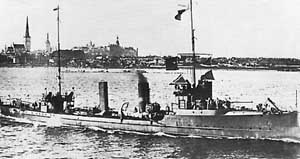 This
afternoon we are planning to meet Mare at Yenisey and dive. In the morning we go out to search with
sonar for the Russian destroyer Kazanets that sunk near Odensholm. Unfortunately the weather is too
hard so we anchor in shelter at the south part of Odensholm. Thus we have an unexpected chance to
visit one of the most famous of the old Swedish settlements in Estonia. The Swedes were forced away
by the Soviet army in 1940 and since then the island has been a Soviet military area until just
recently. We go ashore and take a walk. We arrive to a deserted radio station. There are several high
antennas and different buildings. Technical equipment and some furniture are gone but the rest is
untouched. The soldiers have even left some books by Lenin for us. Then I go to the lighthouse, where
I meet the lighthouse keeper and his family. They are Russians and the only ones living on the island
right now. Finally I visit the church ruin. A few Swedes have already been there and recently placed
new gravestones on the churchyard. This
afternoon we are planning to meet Mare at Yenisey and dive. In the morning we go out to search with
sonar for the Russian destroyer Kazanets that sunk near Odensholm. Unfortunately the weather is too
hard so we anchor in shelter at the south part of Odensholm. Thus we have an unexpected chance to
visit one of the most famous of the old Swedish settlements in Estonia. The Swedes were forced away
by the Soviet army in 1940 and since then the island has been a Soviet military area until just
recently. We go ashore and take a walk. We arrive to a deserted radio station. There are several high
antennas and different buildings. Technical equipment and some furniture are gone but the rest is
untouched. The soldiers have even left some books by Lenin for us. Then I go to the lighthouse, where
I meet the lighthouse keeper and his family. They are Russians and the only ones living on the island
right now. Finally I visit the church ruin. A few Swedes have already been there and recently placed
new gravestones on the churchyard.
Fri 1993-07-09 Kazanets
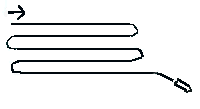 Finally
nice weather! Mare comes to us in the morning. We start searching together for the small Russian
destroyer Kazanets. It sank with 45 men on October 28, 1916 when it hit a mine laid by the German sub
UC27. Finally
nice weather! Mare comes to us in the morning. We start searching together for the small Russian
destroyer Kazanets. It sank with 45 men on October 28, 1916 when it hit a mine laid by the German sub
UC27.
We use our side scan sonar, simultaneously we use our video
plotter connected to a GPS navigator. Thus we know where we have been and try to follow a nice
search pattern (drawing). Eventually we find an appr 25 metres long object on 50 m
depth. In a wide sector south of the object hundreds of small objects are lying up to one km away.
Probably the ship exploded — perhaps by the mine, perhaps when the boiler was filled with ice-cold
water. Apparently only a section is remaining of the ship. We judge that there is not enough left to
see for a dive down to 50 m in the dark Finnish bay. We anchor for the night by Odensholm. 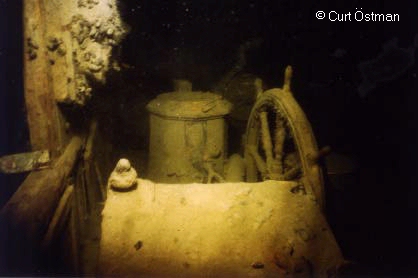 The
evening is ended with a lovely dinner together with Mare's crew. The
evening is ended with a lovely dinner together with Mare's crew.
Sat 1993-07-10 Photography of Yenisey
In the morning we go with Mare to Yenisey. On the spot, according to GPS, Mare first throws in a
buoy with 60 m rope. Then Avo and Kaido go down with a new mooring rope to the wreck. Then Bengt,
Curt, Sten and Kaido go down twice during the afternoon and take photos. They get some very nice
photos from inside the steering house (photos). This will certainly be an exciting
project for the next ten years. Then I get my first dive on Yenisey together with Maik. It is a new
and interesting experience for me. Finally Avo goes down and disconnect the rope and we say goodbye
to Yenisey for this time. We go with Mare to Small Rågö and anchor for the night. Last of all we
enjoy a great grill dinner together with Mare's crew.
Sun 1993-07-11 Vsevolod
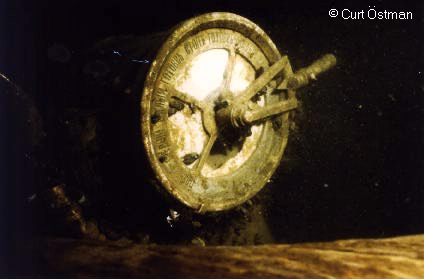 Then we move to another part of the island to search again for Vsevolod, that sank in 1808. First
Mare tows divers on an underwater sledge, but visibility is only 5 metres, so it's difficult to use.
However, Kaido sees a big anchor, maybe from the wreck. Then we make a few dives from Altair. We are
anchored, the sea is calm and the depth is only 15 m.
Then we move to another part of the island to search again for Vsevolod, that sank in 1808. First
Mare tows divers on an underwater sledge, but visibility is only 5 metres, so it's difficult to use.
However, Kaido sees a big anchor, maybe from the wreck. Then we make a few dives from Altair. We are
anchored, the sea is calm and the depth is only 15 m.
Bengt connects Staffan's CD player to Altair's under water loudspeaker and we have Small Rågö's
only under water disco! We hear the music fine under water. So, during our diving we connect our
underwater loudspeaker to a CD player, and we do this easy dive to the tunes of disco music! We seek
at random near Kaido's find. After a while, Staffan and Johan find another anchor and a large iron
cannon, about 2½ m long. But where's the wreck? On the flat rock bottom we see several small rusty
iron fragments, but no wood from the hull. We conclude that the hull has been totally broken to
pieces by the movement of sea and ice, since the depth is only 15 metres. If we dive more, we may
find some wood. But it is our last diving day and we don't have time to look more. Not even to take
photos of the anchors and cannon. Maybe next year... We go to Tallinn for the night.
Mon 1993-07-12
Bengt and Lorelei go to the Russian embassy to get our entry visas. But it is impossible to pass
the long queue of Russians seeking visa to Russia! So we have to try in Petersburg.
Tue 1993-07-13 To Russia
It is time also for Bertil and Leif to sign off. In the morning a tank truck comes with fresh
water for us. Then we leave for Petersburg.
Wed 1993-07-14 St Petersburg
In the morning we reach Petersburg's pilot buoy. We must wait here for the compulsory pilot. The
pilot should have been noticed by our agent about our arrival. But the pilot says he has heard
nothing about us. And when calling our agent nobody is in. So we cannot be cleared to enter the city.
We anchor on 20 m depth and prepare to return to Stockholm in worst case! But after 8 hours the pilot
comes to us and we may continue. We pass the Kronstadt naval base and enter the city. We get a good
place at the Red Fleet embankment on the Neva, one kilometre from the Hermitage. On our deck we have
our electrical US made mini sub, that we never used during this summer. Maybe our little toy sub is
the first American submarine in St Petersburg...
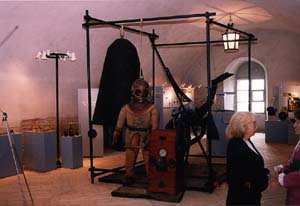 Thu
1993-07-15 The Exhibition Thu
1993-07-15 The Exhibition
On the quay we are guarded by Russian border soldiers. We go ashore and onboard without problems.
But to receive Russian visitors we must hope for the guards' goodwill. Officially visitors are not
allowed to visit our ship's "foreign territory". Bengt and Lorelei participate in the opening of the
marine archaeological exhibition "The Heritage of the Baltic sea", which will tour the Baltic
countries for several years. It is a good exhibition that tells about the unique conditions of the
Baltic sea and the latest technique to find and explore wrecks without destroying them. Next place
for the exhibition is Rostock.
On the opening are among others: Mayor Anatoly Sobchak, archaeologist professor Vadim Masson,
director Per-Inge Lindqvist and Hans Lineskär from Marinmuseum in Karlskrona, Björn-Axel Johansson
(producer of the exhibition), Alexander Prokhorenko and Igor Plushin from the Russian academy of
sciences, and captain Vitaly Dotsenko, teacher at the Russian navy. Unfortunately Anders Franzén from
Sweden can't come as planned.
Fri 1993-07-16
Per-Inge, Björn-Axel, Hans, Maik and I go to see "our" exhibition. It is open to the public for
the first day. It was a hard job setting up because of delays in the Petersburg harbour. Now we check
that it is OK. We take photos and video film the exhibition.
Sat 1993-07-17 Submarine
I visit the navy museum in the morning. There I see a fine model of the mine ship Amur, sister
ship of our project Yenisey. Then I follow a group invited to visit the Soviet submarine D2 from
1931, now a museum. It is very interesting to see this big and relatively advanced sub from the
inside. Finally I visit the zoological museum, artillery museum and the cruiser Aurora. In the
evening we are visited by Natascha Fonekova, archaeologist from the Hermitage.
Sun 1993-07-18
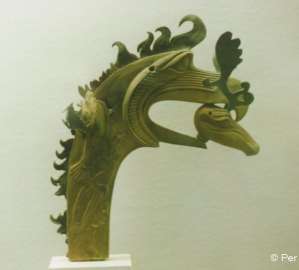 Maik
is invited to visit marine archaeologists in Viborg during the day. They dive on the wrecks from the
Swedish-Russian sea battle in 1790. Unfortunately visibility is said to be
less than one metre in the polluted water, so work is difficult. Maik
is invited to visit marine archaeologists in Viborg during the day. They dive on the wrecks from the
Swedish-Russian sea battle in 1790. Unfortunately visibility is said to be
less than one metre in the polluted water, so work is difficult.
I go to Kunstkammer, the curiosity museum that Peter the great founded in the 18th century. Bengt,
Lorelei and Hans bring the girls and Johan to our exhibition. In the afternoon I go to the Hermitage
and admire the 2500 year old Scythian wood carvings (photo). They are from a grave
mound that was excavated 1929-49 in the Pazyryk valley in the Altai mountain area. There were also
clothes, silk, a wooden carriage, and even food, in a preserved condition.
Mon 1993-07-19
Bengt, Lorelei and the children go to Kunstkammer. Maik and I visit the impressive
Isaac cathedral with its gilded roof and nice view from the
sightseeing terrace.
Tue 1993-07-20 To Sweden
We are invited for breakfast onboard the luxury yacht Michaela Rose. The ship is owned by a
gentleman from Dallas, Texas. He and his wife give us a great breakfast and interesting talk, he is
interested in underwater archaeology. In the afternoon Lorelei and I make a last visit to the
Hermitage guided by Natasha. In the evening we are invited to a cocktail party with our new friends
on the Michaela Rose. Unfortunately our pilot is already booked and can't be changed. At 1730 hours
we leave for Sweden. We are not in a hurry, so despite the calm weather we anchor for the night
outside Seskar island.
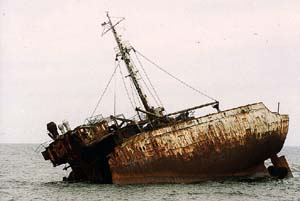 Wed
1993-07-21 Wed
1993-07-21
Outside Sommer's lighthouse we see a fine wreck: A cargo ship has been thrown to the rock and
split in two. The big bronze propeller is still there so the wreck can't be old. In the rear we can
barely see the name Kura from Odessa. Later, two sea miles away, we are met by a cruiser and a
destroyer going to Petersburg — probably to celebrate the Russian navy day.
Thu 1993-07-22 Stockholm
We continue to Stockholm and arrive shortly after midnight. That is the end of the journey. I go
home, Johan is driven home, and the rest sleep onboard.
Fri 1993-07-23 Goodbye!
In the morning Hans goes by plane home to Karlskrona. I join Maik to the railway station and he
gets a ticket on the afternoon train. We all say goodbye to each other onboard. I particularly wish
to thank Bengt and Lorelei for all friendship and good food.
Postscript
In 1997 the investigation of Yenisey, and other older wrecks, has not been continued. There is
little money for underwater archaeology in Estonia. In a way this is typical for all underwater
archaeology. Each project carries costs, not only during an expedition, but also for a long time
ahead, for e.g. conservation and storage of objects. Thus Yenisey will rest in peace again for some
time.
In Estonia, wrecks have been located, that are older and probably more interesting than Yenisey.
But money is needed for diving and making preliminary inspections. Sponsors are welcome!
Our side scan sonar was a model 260 with a paper plotter, from EG&G Marine Instruments, USA. This
model is dual-frequency, so we scanned at 100 and 500 KHz. Our normal working range was set to 100 or
200 metres. We constantly traced our course and position using our video plotter, connected to a GPS
satellite navigator. Read more about side scan sonar.
Related links
The Baltic Operations 1914-1916
© Per Åkesson, 1993
web published 1996, last revision 1999
My photos were made with Nikon FE-2 and FM-2,
using various lenses, e.g. Tokina 28-85/4 and Nikkor 50/1.4.
Curt Östman's underwater photos were made with Nikonos 5 and 28 mm lens. The
archive photo of Yenisey is from the Estonian maritime museum. |










 Finally
nice weather! Mare comes to us in the morning. We start searching together for the small Russian
destroyer Kazanets. It sank with 45 men on October 28, 1916 when it hit a mine laid by the German sub
UC27.
Finally
nice weather! Mare comes to us in the morning. We start searching together for the small Russian
destroyer Kazanets. It sank with 45 men on October 28, 1916 when it hit a mine laid by the German sub
UC27. The
evening is ended with a lovely dinner together with Mare's crew.
The
evening is ended with a lovely dinner together with Mare's crew. Then we move to another part of the island to search again for Vsevolod, that sank in 1808. First
Mare tows divers on an underwater sledge, but visibility is only 5 metres, so it's difficult to use.
However, Kaido sees a big anchor, maybe from the wreck. Then we make a few dives from Altair. We are
anchored, the sea is calm and the depth is only 15 m.
Then we move to another part of the island to search again for Vsevolod, that sank in 1808. First
Mare tows divers on an underwater sledge, but visibility is only 5 metres, so it's difficult to use.
However, Kaido sees a big anchor, maybe from the wreck. Then we make a few dives from Altair. We are
anchored, the sea is calm and the depth is only 15 m.



 Back to Nordic Underwater Archaeology
Back to Nordic Underwater Archaeology